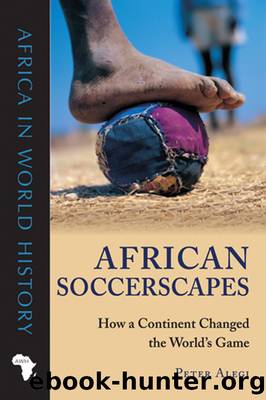African Soccerscapes: How a Continent Changed the Worldâs Game by Peter Alegi

Author:Peter Alegi [Alegi, Peter]
Language: eng
Format: epub
Tags: History, Africa, General, Sports & Recreation, Basketball
ISBN: 9780896804722
Google: NrW50yHkr0EC
Goodreads: 7509753
Publisher: Ohio University Press
Published: 2010-02-14T00:00:00+00:00
After 1980: Increased Movement of Africans in the Era of Commercial Football
The flow of African footballers to Europe increased in the 1980s and 1990s, a trend some labeled a âNew Scramble for Africa.â56 Regulatory changes quickened the pulse of migration. Many European leagues began to allow a small number of foreigners per team, usually no more than two or three (though citizenship rules differed from country to country). In 1981, FIFA introduced a rule that forced all clubs to release their players for international duty. This rule made it easier to implement article 3 of the FIFA constitution, which states that every citizen of a member nation is eligible to play for his (or her) country. Then, in 1982, CAF rescinded a rule imposed in 1965 that limited the number of overseas-based players on national teams to two.
The result of this lowering of barriers to movement to and from Africa was an increase in the number of Europe-based African players in the African Nations Cup, as well as the World Cup and other international tournaments. This oscillating flow of elite players between African nations and European clubs changed the way the African game was played and how it was perceived internationally. Greater access to football via television and video recorders, together with a steady influx of European coaches, aligned African football with global trends, whereby âorganization, the avoidance of mistakes, the ability to take chances and the reduction of risk seem to be the aim of all teams in major championships.â57 Suffocating defense, constant running, collective movements, and declining individual creativity tended to standardize styles of play. âI think there was more individual brilliance in my day,â said Salif Keita, the former African Footballer of the Year, âbut the teamwork and collective movement is so much better now.â58
A dramatic improvement in African teamsâ performances in international tournaments nourished Europeâs gluttonous demand for players. As noted in chapter 4, the 1982 World Cup proved to be a transformative event for the African game. Global satellite television broadcasts of Algeria and Cameroonâs exploits against Germany, Italy, and other top teams displayed Africaâs world-caliber technical, tactical, and physical skills. Africaâs dazzling success at youth level further stimulated European interest in young African players, as Nigeria and Ghana each won two junior world championships.
Africaâs success on the world stage and expanding media coverage of world football prompted an exodus of elite players from the continent after 1982. A review of the list of African Footballer of the Year recipients bears this out. Between 1971 and 1981 every winner of the award played for a club in Africa. Between 1982 and 2007, however, all but two of the winners played in European clubs.59 The Algerian attacking midfielder Rabah Madjer and the veteran Cameroonian striker Roger Milla reaped immediate rewards. Having scored in Algeriaâs historic win over West Germany, Madjer played for Racing Club Paris and then FC Porto. He scored a mesmerizing back-heel goal against Bayern Munich in 1987 to help Porto win the European Cupâthe first triumph for a Portuguese side since Benficaâs twenty-five years earlier.
Download
This site does not store any files on its server. We only index and link to content provided by other sites. Please contact the content providers to delete copyright contents if any and email us, we'll remove relevant links or contents immediately.
Futebol by Alex Bellos(2301)
No Hunger In Paradise by Michael Calvin(1772)
Pep Confidential by Martí Perarnau(1734)
Cristiano Ronaldo: The Biography by Guillem Balague(1515)
Sir Matt Busby by Patrick Barclay(1495)
ALEX FERGUSON My Autobiography by Alex Ferguson(1491)
The Game of Our Lives by David Goldblatt(1480)
Cyrille Regis: My Story by Cyrille Regis(1464)
No Nonsense by Joey Barton(1444)
Football's Strangest Matches by Andrew Ward(1435)
Angels with Dirty Faces by Jonathan Wilson(1395)
The Lost Boys by Ed Hawkins(1380)
Red Card by Ken Bensinger(1348)
Soccer Men: Profiles of the Rogues, Geniuses, and Neurotics Who Dominate the World's Most Popular Sport by Simon Kuper(1248)
A Season With Verona by Tim Parks(1225)
Forward: A Memoir by Abby Wambach(1210)
We Are the Damned United by Phil Rostron(1199)
Scholes : My Story (9781471125799) by Scholes Paul(1196)
50 Complete Goalkeeping Training Sessions by Hageage Tamara Browder(1184)
